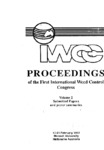Por favor, use este identificador para citar o enlazar este ítem:
http://www.alice.cnptia.embrapa.br/alice/handle/doc/11007Registro completo de metadatos
| Campo DC | Valor | Lengua/Idioma |
|---|---|---|
| dc.contributor.author | CERDEIRA, A. L. | pt_BR |
| dc.contributor.author | FORSTER, R. | pt_BR |
| dc.date.accessioned | 2011-04-10T11:11:11Z | pt_BR |
| dc.date.available | 2011-04-10T11:11:11Z | pt_BR |
| dc.date.created | 1993-11-24 | pt_BR |
| dc.date.issued | 1992 | pt_BR |
| dc.identifier.citation | In: INTERNATIONAL WEED CONTROL CONGRESS, 1., 1992, Melbourne. Proceedings. Melbourne: Monash University, 1992. | pt_BR |
| dc.identifier.uri | http://www.alice.cnptia.embrapa.br/alice/handle/doc/11007 | pt_BR |
| dc.description | The persistence of the herbicide picloran (4-amino - 3,5,6 - trichloropicolinic acid) was studied in "Latossolo vermelho" soil (36% clay, 2% organic matter) in Jaguariuna county, Sao Paulo, Brazil. The herbicide was sprayed on plowed soil in March, 1989, at rates of 0.0; 0.56 and 1.12 g/ha. Picloran persistence was evaluated using bioassay with bean (Phaseolus vulagris L.). The data showed that the herbicide was very persistent up to 180 days, just at the raining season, October to December. At the same interval, from 180 to 240 days, typical visual symptoms disappeared, although there were still effects on height of plants, length of leaves and dry weight. No effect of the herbicide was detected after 300 days. | pt_BR |
| dc.language.iso | eng | eng |
| dc.rights | openAccess | eng |
| dc.subject | Herbicide | pt_BR |
| dc.subject | Persistence | pt_BR |
| dc.title | Persistence of picloran in Brazilian soil. | pt_BR |
| dc.type | Resumo em anais e proceedings | pt_BR |
| dc.date.updated | 2015-11-10T11:11:11Z | pt_BR |
| dc.subject.nalthesaurus | chemical control | pt_BR |
| dc.subject.nalthesaurus | beans | pt_BR |
| dc.subject.nalthesaurus | picloram | pt_BR |
| dc.subject.nalthesaurus | weeds | pt_BR |
| dc.subject.nalthesaurus | soil | pt_BR |
| dc.format.extent2 | p.117 | pt_BR |
| riaa.ainfo.id | 11007 | pt_BR |
| riaa.ainfo.lastupdate | 2015-11-10 | pt_BR |
| dc.contributor.institution | ANTONIO LUIZ CERDEIRA, CNPMA; REINALDO FORSTER, CNPMA. | pt_BR |
| Aparece en las colecciones: | Resumo em anais de congresso (CNPMA)  | |
Ficheros en este ítem:
| Fichero | Descripción | Tamaño | Formato | |
|---|---|---|---|---|
| 1992RAs003.pdf | 50.38 kB | Adobe PDF |  Visualizar/Abrir |









